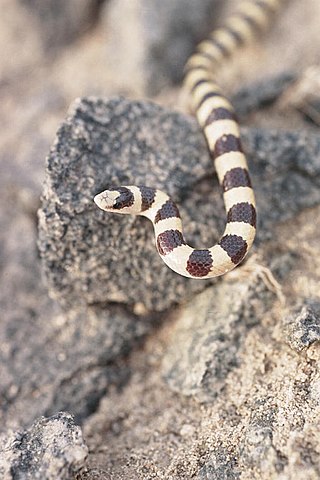Top Qs
Timeline
Chat
Perspective
Western shovelnose snake
Species of snake From Wikipedia, the free encyclopedia
Remove ads
The western shovel-nosed snake (Chionactis occipitalis[2]) is a small species of snake of the family Colubridae.
Remove ads
Description
A small (11-17 in.) snake with alternating bands of orange and tan on cream or tan on cream. Less commonly specimens have been documented as having black bands on white. The snout is usually cream to light yellow and has a noticeable point to assist in digging. The small black eyes are covered by a black mask. The western shovel-nosed snake is distinguished from the similar looking coral snake, by the yellow snout and lack of full banding around the belly. A similar species, the Sonoran Shovel-nosed Snake has less than 20 bands on its body.
Remove ads
Geographic Range
The snake is found in the United States (Arizona, California, Nevada) and Mexico.[3] The snake is primarily found in Sonoran Desert scrub or Mojave Desert scrub. [4]
Diet
The western shovel-nosed snake feeds on a variety of invertebrates including insects, spiders, and scorpions. They have been documented eating the eggs of other reptiles.[5]
Behavior
Snakes are primarily fossorial. The Western shovel-nosed Snake spends most of its life in sand or sandy soil, with peak activity for the species occurring in the spring. Mating takes place in the spring and adult females will lay up to nine eggs in the summer.[6]
Subspecies
There are three subspecies currently recognized.[7]
C.occipitalis annulata - Colorado Desert Shovel-nosed Snake
C. occipitalis klauberi - Tucson Shovel-nosed Snake
C. occipitalis occipitalis - Mohave Shovel-nosed Snake
References
External links
Wikiwand - on
Seamless Wikipedia browsing. On steroids.
Remove ads



